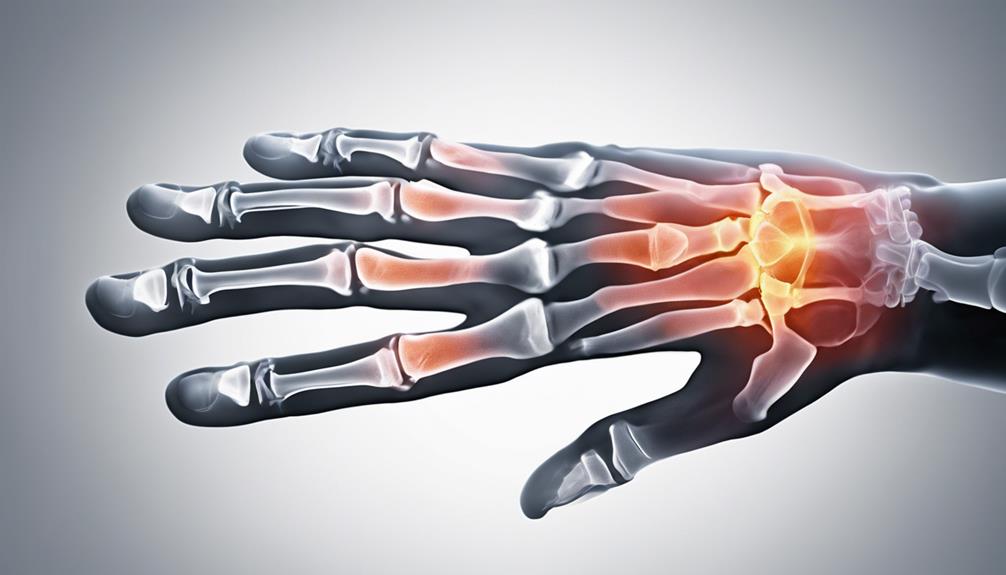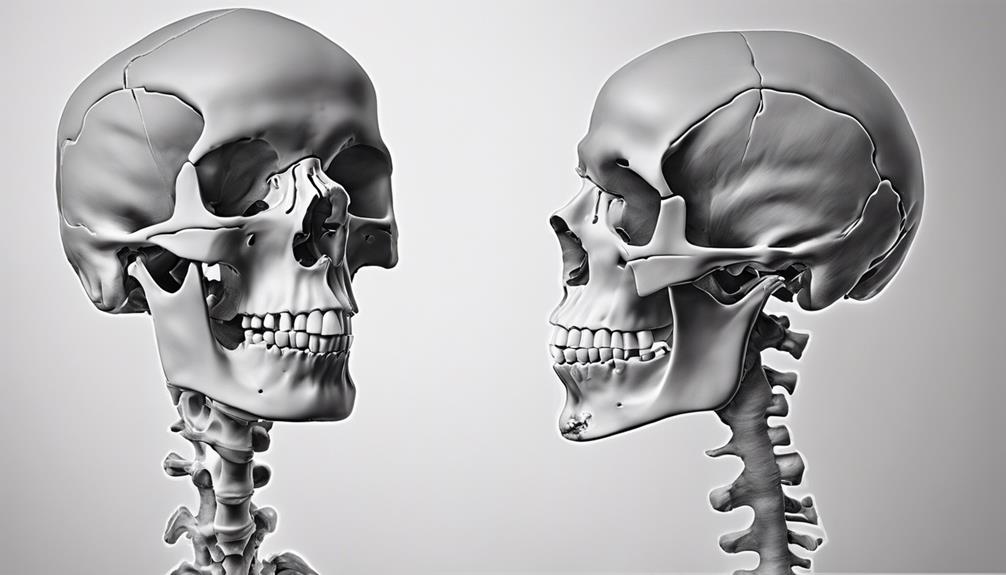Arthritis Management
What ICD code is used for Septic Arthritis?
Hone your understanding of ICD-10 Septic Arthritis to unravel the complexities of this intricate medical condition, setting the stage for a deeper dive into the world of infectious arthropathies.

Let’s delve into the intricacies of ICD-10 Septic Arthritis, much like deciphering a complicated medical enigma. Grasping the subtleties of this ailment is not about having a basic understanding; it necessitates a sharp focus on the specifics and accuracy in diagnostic coding.
As we venture into the realm of infectious arthropathies, the intricacies of differentiating reactive from postinfective arthropathies come to light, setting the stage for a deeper exploration of the importance of accurate coding.
Stay tuned as we uncover the critical role proper coding plays in the realm of healthcare management and patient care.
Key Takeaways
- Accurate bacterial identification crucial for coding septic arthritis.
- Utilize specific ICD-10 codes and include B96 for bacteria.
- Precise documentation essential for proper reimbursement and care.
- Compliance with coding guidelines enhances accuracy and patient outcomes.
ICD-10-CM Coding Overview
When assigning ICD-10 codes for septic arthritis, we must ensure accurate identification of the specific bacterial etiology to facilitate appropriate treatment. In the case of septic arthritis with hand involvement, utilizing the ICD-10-CM code M00.849 is crucial. This code specifically addresses arthritis caused by other bacteria and is essential for precise diagnosis and treatment planning. Additionally, it's recommended to include an additional code, B96, to specify the exact bacteria responsible for the infection.
ICD-10-CM code M00.849 falls under the broader category of infectious arthropathies due to microbiological agents. Proper coding of septic arthritis not only aids in accurate diagnosis but also plays a significant role in ensuring appropriate reimbursement for medical services. Understanding the nuances of ICD-10-CM coding for septic arthritis is paramount for effective medical documentation and billing processes. By meticulously assigning the correct codes, clinicians can streamline the diagnosis and treatment of septic arthritis, ultimately benefiting patient care and outcomes.
Specific Septic Arthritis Codes

The specific ICD-10-CM codes for septic arthritis provide detailed classification based on the affected site and bacterial etiology. Proper coding of septic arthritis is crucial for accurate diagnosis and billing. Here are key points to consider:
- M00.80: Used for septic arthritis at an unspecified site.
- M00.829: Designated for septic arthritis caused by other specified bacteria.
- M00.862: Specifically for septic arthritis affecting the left knee.
When assigning ICD-10 codes for septic arthritis, it's essential to include additional code B96 to identify the specific bacteria responsible for the infection. This additional information ensures precise tracking of joint infections and facilitates appropriate medical treatment.
Understanding the nuances of septic arthritis codes in ICD-10-CM is vital for proper documentation and reimbursement. By accurately documenting the affected site and the causative bacteria, healthcare providers can streamline the coding process and optimize patient care.
Documentation and Billing Guidelines
To ensure accurate reimbursement and treatment planning for septic arthritis, precise documentation of the bacterial cause is essential. Proper documentation plays a pivotal role in the diagnosis and management of septic arthritis. Healthcare providers must accurately record all relevant clinical information, including the specific bacterial cause, to facilitate coding accuracy and appropriate treatment planning.
Billing guidelines for septic arthritis necessitate the use of specific ICD-10 codes to ensure proper reimbursement for services rendered. Understanding the nuances of documenting septic arthritis not only aids in coding accuracy but also streamlines the billing process, ultimately enhancing healthcare administration efficiency.
Compliance with documentation and billing guidelines is paramount for healthcare facilities to operate smoothly and provide quality care to patients with septic arthritis. By adhering to these guidelines, healthcare professionals can contribute to improved patient outcomes and overall healthcare system effectiveness.
Importance of Accurate Coding

Accurate coding for septic arthritis in ICD-10 is imperative to ensure precise diagnosis and appropriate reimbursement. Proper coding not only aids in identifying the specific bacteria causing septic arthritis but also helps in understanding the infection source. Compliance with coding guidelines is essential for maintaining accurate medical records of septic joint cases.
- Utilizing additional codes like B96 assists in pinpointing the causative bacteria responsible for septic arthritis.
- Including external cause codes may be necessary to determine the source of the infection leading to septic arthritis.
- Adhering to coding guidelines enhances compliance and ensures the quality of medical records, ultimately improving patient care for individuals with septic arthritis.
Tips for Proper Coding
Regularly reviewing and implementing updated coding guidelines is crucial for ensuring precision in documenting septic arthritis cases. When assigning the ICD-10 code for septic arthritis due to other bacteria in the elbow, it's essential to use M00.80.
Additionally, incorporating the additional code B96 to identify the specific bacteria causing the infection is necessary for accurate coding and billing purposes. Proper documentation is key in differentiating septic arthritis from other forms of arthritis to avoid coding errors and ensure appropriate treatment.
Staying informed about coding changes and revisions is vital to maintaining accuracy in medical documentation and reimbursement claims. By adhering to coding guidelines and documenting the details meticulously, healthcare professionals can facilitate seamless communication between providers and accurately reflect the complexity of septic arthritis cases in the healthcare setting.
Frequently Asked Questions
What Is the ICD-10 Code for Septic Arthritis?
The ICD-10 code for septic arthritis is M00.9, falling under infectious arthropathies. It's crucial to use additional codes like B95-B97 to specify the infectious agent.
Septic arthritis, joint inflammation from infection, is a serious condition. Accurate coding is essential for diagnosis, treatment, and reimbursement. Understanding the specific ICD-10 code aids in managing this debilitating condition effectively.
What Is Septic Arthritis?
Septic arthritis is a serious joint condition stemming from an infection. It causes pain, swelling, and restricted movement. Timely diagnosis and antibiotic treatment are vital to prevent lasting joint harm.
The primary culprit of septic arthritis is bacterial invasion. Risk factors include age, prior joint injuries, immune compromise, and existing joint problems. Quick action is key to halting its progression and safeguarding joint health.
What Is the ICD-10 Code for Septic Prosthetic Arthritis?
When addressing the ICD-10 code for septic prosthetic arthritis, it's crucial to utilize T84.50XA. This code pinpoints infections and inflammatory responses linked to internal joint prostheses.
Proper coding ensures accurate documentation and billing for treatment. Remember, T84.50XA necessitates additional characters to specify the affected joint and laterality, aiding in precise identification and care planning.
What Is the ICD-10 Code for M17 11?
The ICD-10 code for M17.11 is osteoarthritis of the knee, right knee, with other specified pathological fracture.
It's crucial to accurately assign this code to ensure proper tracking and management of cases involving this specific condition.
Correct documentation and coding are essential for effective diagnosis and treatment planning.
Timely identification of osteoarthritis with associated fractures aids in providing appropriate care and preventing further complications.
Conclusion
In conclusion, accurate coding for septic arthritis is essential for effective patient care and reimbursement.
Just as a skilled surgeon meticulously sutures a wound to promote healing, precise coding ensures the proper treatment and management of this infectious arthropathy.
By following documentation guidelines and utilizing specific ICD-10-CM codes, healthcare providers can successfully navigate the complexities of diagnosing and treating septic arthritis, ultimately improving patient outcomes.
Albert brings a wealth of knowledge and expertise to our writing team. With a background in caregiving and a deep understanding of the challenges faced by caregivers, Albert’s writing resonates with authenticity and empathy. He is committed to delivering high-quality content that empowers and supports caregivers on their journey.
Arthritis Management
How to Use Poke Berries for Arthritis Relief
Tantalizingly promising yet shrouded in uncertainty, the potential of poke berries for arthritis begs further exploration to unveil its true impact.

In our investigation into the advantages of using nature-based therapies for managing arthritis, an interesting topic that comes up is the use of pokeberries. These brightly colored berries have garnered attention due to their claimed anti-inflammatory qualities, potentially providing relief to individuals experiencing joint pain.
However, the safety and efficacy of poke berries in arthritis treatment remain uncertain, prompting us to delve deeper into the research and considerations surrounding their use.
Are you curious to uncover the full scope of information on this botanical remedy and its implications for arthritis management?
Key Takeaways
- Poke berries reduce joint pain and swelling in arthritis.
- Incorporating poke berries aids in managing arthritis symptoms.
- Anti-inflammatory properties of poke berries benefit joint health.
- Poke berries offer natural relief with immune-stimulating and antioxidant effects.
Potential Anti-Inflammatory Properties of Poke Berries
Poke berries exhibit promising anti-inflammatory properties that could aid in alleviating arthritis symptoms by modulating key inflammatory pathways. Research indicates that compounds found in poke berries can potentially reduce joint pain and swelling associated with arthritis. These berries are believed to have immune-stimulating effects, which may benefit individuals struggling with arthritis symptoms. Studies suggest that certain constituents in poke berries could regulate the inflammatory pathways linked to arthritis, offering a natural means of support for managing this condition.
Incorporating poke berries into one’s diet could be valuable to an arthritis management plan due to their anti-inflammatory potential. By leveraging the anti-inflammatory properties of poke berries, individuals may experience relief from the discomfort caused by arthritis. Further research into the specific mechanisms by which poke berries exert their anti-inflammatory effects could provide additional insights into their potential therapeutic benefits for arthritis sufferers.
Reduction of Joint Pain With Poke Berries

Evidence suggests a potential reduction in joint pain associated with arthritis through the consumption of poke berries. Studies have shown that the anti-inflammatory properties found in poke berries could play a role in alleviating arthritis symptoms. Here are some key points to consider when exploring the use of poke berries for managing joint pain:
- Poke berries contain compounds that may help reduce inflammation in the joints.
- Preliminary findings indicate a positive impact of poke berries on arthritis-related joint pain.
- The anti-inflammatory effects of poke berries may assist in easing swelling and stiffness commonly experienced with arthritis.
- Incorporating poke berries into your diet offers a natural approach to potentially relieving arthritis discomfort.
- It’s essential to consult with a healthcare provider for personalized advice before making any significant changes to your arthritis management plan.
Ways to Incorporate Poke Berries Into Daily Routine
Incorporating poke berries into one’s daily diet can offer a natural and potentially beneficial approach to managing arthritis symptoms. These berries are reported to have immune-stimulating properties that may help alleviate arthritis discomfort.
To incorporate poke berries into your routine, consider adding them to smoothies, salads, or using them as a topping for yogurt or oatmeal. It’s crucial to consult a healthcare provider before consuming poke berries for arthritis to ensure they’re safe and suitable for your specific health condition.
Remember that poke berries contain toxic seeds, so it’s essential to consume only the berry flesh and avoid ingesting the seeds. Start with small amounts of poke berries to evaluate any potential benefits or adverse reactions for arthritis relief.
Supporting Joint Health With Poke Berries

To further explore the potential benefits of poke berries for supporting joint health in individuals with arthritis, it’s crucial to understand their traditional uses and the compounds that contribute to their anti-inflammatory properties. Poke berries have a long history of being used to alleviate joint pain and inflammation, making them a promising natural support for those dealing with arthritis. The anti-inflammatory properties of poke berries can play a key role in managing arthritis symptoms by reducing swelling and discomfort in the joints. Additionally, the antioxidants present in poke berries are essential for combating oxidative stress and inflammation, promoting overall joint health.
Benefits of Supporting Joint Health With Poke Berries:
- Poke berries may help reduce joint pain associated with arthritis.
- The anti-inflammatory properties of poke berries can alleviate swelling in the joints.
- Antioxidants in poke berries combat oxidative stress, supporting joint health.
- Incorporating poke berries into the diet may improve joint mobility.
- Consumption of poke berries in moderation could aid in reducing arthritis-related discomfort.
Benefits of Poke Berries for Arthritis
Exploring the potential benefits of poke berries for arthritis reveals promising anti-inflammatory properties that may help alleviate symptoms and improve joint function. Poke berries contain compounds that can reduce inflammation and provide pain relief for individuals with arthritis. These berries also have immune-stimulating properties, which may be particularly beneficial for those with autoimmune forms of arthritis. The antioxidants found in poke berries contribute to their anti-inflammatory effects, making them a natural remedy worth considering for arthritis management. By incorporating poke berries into a balanced diet, individuals can complement conventional arthritis medications with a potentially gentler alternative. Below is a table summarizing the key benefits of poke berries for arthritis:
Benefit Description Anti-inflammatory Reduces inflammation in the joints, potentially alleviating arthritis symptoms. Pain relief Helps alleviate pain associated with arthritis, improving overall quality of life. Joint function Improves joint mobility and function, enhancing daily activities for individuals with arthritis. Immune-stimulating Supports the immune system, which can be beneficial for autoimmune forms of arthritis. Natural remedy Provides a natural alternative to conventional medications, with potentially fewer side effects.
Frequently Asked Questions
What Are the Benefits of Pokeweed Berries?
Pokeweed berries offer potential benefits such as anti-inflammatory properties that could help alleviate joint pain and inflammation. While limited scientific evidence supports their efficacy for arthritis, these berries may provide some relief.
Consulting a healthcare provider before using pokeweed berries is crucial. Their anti-inflammatory effects show promise, yet individual responses may vary.
It’s important to approach natural remedies like pokeweed berries with caution and proper medical guidance.
What Did the Native Americans Use Poke Berries For?
We utilized poke berries for various purposes, like dyeing fabrics and creating vibrant paints.
Despite their toxic nature, Native Americans refrained from consuming them. The berries held significance in cultural practices, often used for decorative arts and ceremonies.
Their symbolic value outweighed their toxicity, making them a staple in our customs. This historical context sheds light on the diverse roles poke berries played in Native American traditions.
How Do You Make Pokeweed for Medicinal Purposes?
When making pokeweed for medicinal purposes, we harvest the root in the fall or early spring when the plant is less than a foot tall.
Chopped roots are soaked in alcohol for six weeks to create tinctures that extract medicinal properties.
Monitoring dosages is crucial due to individual tolerance levels.
Medicinally, pokeweed is used for conditions like sore throats, respiratory infections, and breast cysts.
If severe side effects occur, seek medical advice promptly.
Is Pokeweed a Narcotic?
Pokeweed is classified as an herb of undefined safety with narcotic effects by the FDA. It contains toxic components, especially in the rootstock, leading to severe symptoms if ingested.
Consumption of pokeweed, including its berries, isn’t recommended due to potential toxicity. Adverse reactions can include gastrointestinal distress and other severe toxicities.
Pokeweed should be handled with caution due to its narcotic effects and harmful consequences if consumed.
Conclusion
In conclusion, incorporating poke berries into your daily routine may offer potential benefits for arthritis by harnessing their anti-inflammatory properties.
However, like navigating through a dense forest, caution and guidance are essential to avoid potential pitfalls.
While the path may be uncertain, exploring the potential of poke berries in supporting joint health could lead to a brighter future for managing arthritis symptoms.
Proceed with care, for the journey towards relief may be both treacherous and rewarding.
Albert brings a wealth of knowledge and expertise to our writing team. With a background in caregiving and a deep understanding of the challenges faced by caregivers, Albert’s writing resonates with authenticity and empathy. He is committed to delivering high-quality content that empowers and supports caregivers on their journey.
Arthritis Management
What Does Arthritis Look Like on an Xray: A Visual Guide
Step into the world of arthritis through X-ray images, where shadows and shapes unveil the secrets of joint degeneration and inflammation.

Looking at an X-ray picture of arthritis, it’s akin to interpreting a silent script composed of shadows and forms. The complex patterns disclosed in these pictures provide a window into the realm of joint deterioration and swelling.
As we observe the subtle changes within the bones and surrounding structures, a deeper understanding unfolds, shedding light on the progression of this common condition. But what exactly does arthritis look like on an X-ray, and how can these visual clues impact diagnosis and treatment decisions?
Let's explore the visual manifestations of arthritis through the lens of X-ray imaging to uncover the secrets hidden within these captivating images.
Key Takeaways
- Joint space narrowing is a common indicator of arthritis on X-ray.
- Bone spurs or osteophytes are visible signs of arthritis in X-ray images.
- Cyst formation can be observed in joints affected by arthritis.
- Subchondral sclerosis is a characteristic feature seen in arthritic joints on X-ray.
Characteristics of Arthritis on X-ray
When analyzing arthritis on an X-ray, the characteristic findings include joint space narrowing, subchondral sclerosis, osteophyte formation, and cyst development.
Osteoarthritis, the most common type of arthritis, manifests on X-rays by showing a reduction in the space between the joints due to cartilage wear and tear. This narrowing is a key indicator of degeneration in the affected joints.
Subchondral sclerosis, seen as denser bone beneath the cartilage, indicates the body's attempt to reinforce the weakened joint structure.
Osteophytes, also known as bone spurs, are bony outgrowths that form around arthritic joints, serving as stabilizers but potentially causing pain and limited mobility.
Additionally, cysts may develop near arthritic joints as a response to the increased pressure and inflammation in the area. These characteristic findings on X-rays provide valuable insights into the extent and nature of arthritis affecting the bones and joints, aiding in accurate diagnosis and treatment planning.
X-ray Findings in Arthritic Joints

In assessing arthritic joints on X-rays, the narrowed space between bones serves as a prominent indicator of cartilage loss. This narrowing is a hallmark of osteoarthritis, reflecting the wear-and-tear processes affecting the joint.
Additionally, the X-ray images may reveal the presence of bone spurs or osteophytes along the edges of the affected joints. These bony changes can contribute to joint deformity, leading to a crooked appearance in severe cases of arthritis.
Furthermore, small bone cysts within the joint may be visible on X-rays, indicating the progression of the disease. Comparing these findings to a normal X-ray can help healthcare providers pinpoint specific changes characteristic of arthritis, aiding in diagnosis and treatment planning.
Thorough evaluation of these X-ray features is crucial in identifying and monitoring conditions like thumb arthritis, guiding effective management strategies for patients.
Identifying Arthritis Through X-ray Imaging
Upon examination of X-ray images, the identification of arthritis is characterized by joint space narrowing, bone spurs, osteophytes, cyst formation, and visible joint deformities. These features help healthcare professionals diagnose arthritis and plan appropriate treatment. The table below summarizes the key markers of arthritis visible on X-ray imaging:
| Arthritis Feature | Description |
|---|---|
| Joint Space Narrowing | Indicates cartilage loss and degeneration in the joint |
| Bone Spurs/Osteophytes | Bony outgrowths at joint edges contributing to symptoms |
| Cyst Formation | Fluid-filled sacs within the bone indicative of arthritis |
| Joint Deformities | Abnormal joint shapes leading to a crooked appearance |
Visual Signs of Arthritis on X-ray

Moving from the identification of arthritis features on X-ray imaging, our focus now shifts to visually discerning the subtle signs of arthritis through detailed radiographic analysis. When examining X-ray images for signs of arthritis, several key visual indicators can help in the diagnosis.
- Joint space narrowing: A common feature indicating cartilage loss in arthritic joints.
- Bone spurs or osteophytes: Visible bony projections that develop around arthritic joints.
- Crooked finger appearance: An angular deformity often seen in patients with arthritis.
- Subchondral cysts: Fluid-filled sacs that can be observed around affected joints on X-rays.
- Joint sclerosis: Increased bone density, suggestive of arthritis, evident on X-ray imaging.
Arthritis Manifestations in X-ray Images
Analyzing arthritis manifestations in X-ray images reveals distinct visual cues that aid in the precise identification and assessment of the disease's progression. In these images, joint space narrowing is a common finding, indicating cartilage loss, a hallmark feature of arthritis.
Additionally, the presence of bone spurs or osteophytes along the edges of the joints is often observed, contributing to the characteristic appearance of arthritis on X-ray. Subchondral sclerosis, characterized by increased bone density, is another key feature visible on X-ray images of arthritic joints.
Furthermore, the formation of cysts around affected joints can be visualized, providing further insight into the extent of the disease. In advanced cases, arthritis can lead to joint deformities and alterations in normal bone alignment, which are evident in X-ray images.
Frequently Asked Questions
How Can Doctors Tell if You Have Arthritis?
Doctors can diagnose arthritis through physical examinations, medical history assessment, and imaging tests like X-rays. Signs such as joint pain, stiffness, swelling, and limited range of motion are key indicators. Blood tests can also help identify specific types of arthritis.
Once clinical symptoms are considered, imaging techniques like X-rays can confirm the presence of arthritis by revealing characteristic changes in the affected joints' bone structure and alignment.
What Does the Beginning of Arthritis Look Like?
At the beginning stages, arthritis may present with subtle joint space narrowing and minimal osteophyte formation. Initial signs could include mild subchondral sclerosis and small cysts or bony erosions near the joint. Deformities or significant cartilage loss may not be prominent on X-ray imaging initially.
These early findings indicate mild bone changes and serve as crucial indicators for diagnosing arthritis. Early detection allows for timely intervention and management of the condition.
Conclusion
In conclusion, when examining X-ray images for signs of arthritis, it's important to look for characteristic features such as:
- Joint space narrowing
- Bone spurs
- Cysts
- Joint deformities
These findings can help diagnose arthritis early on and guide treatment decisions.
But have we truly explored all the nuances and intricacies of arthritis manifestations in X-ray images?
Albert brings a wealth of knowledge and expertise to our writing team. With a background in caregiving and a deep understanding of the challenges faced by caregivers, Albert’s writing resonates with authenticity and empathy. He is committed to delivering high-quality content that empowers and supports caregivers on their journey.
Arthritis Management
Mattress Options for Arthritis Relief
Get ready to discover the ultimate solution for arthritis relief with the best mattress options tailored to your needs.

In the realm of sleep surfaces, discovering the ideal mattress for arthritis sufferers is akin to looking for a needle in a vast haystack. Picture the comfort of descending into a cloud-like bed, where your sore joints are at last comforted by the gentle yet firm support of the mattress.
But how do you know which mattress will be the game-changer for your arthritis symptoms? Let's explore the key features and options that could make a significant difference in your quality of sleep and daily comfort.
Key Takeaways
- Memory foam molds to body, offering support for arthritis sufferers.
- Medium-firm mattresses balance cushioning and support for arthritis relief.
- Zoned support systems maintain proper posture, crucial for arthritis comfort.
- Hybrid mattresses combine memory foam and coils for arthritis support and comfort.
Top Mattress for Arthritis Relief
When selecting the best mattress for arthritis relief, prioritizing features like pressure relief and support is crucial for improving sleep quality and reducing discomfort. For arthritis sufferers, a Memory Foam Mattress can be a game-changer. Memory foam molds to the body, providing excellent support and pressure relief, which is essential for alleviating joint pain.
Different sleep positions can affect arthritis symptoms, making it vital to choose a mattress that caters to various sleeping styles. Motion isolation is another key factor to consider, as it minimizes disturbances caused by movement, promoting uninterrupted sleep for those with arthritis.
Temperature regulation is significant for ensuring a comfortable sleep environment, especially for individuals with arthritis who may be sensitive to temperature changes. Firmness levels also play a role in pain relief, with options available to suit different body types and preferences.
Best Mattress for Back Pain

What makes the best mattress for back pain relief stand out among other options on the market? When dealing with back pain, it's essential to choose a mattress that offers both support and comfort. Opting for a medium-firm mattress can help alleviate back pain by providing the right balance of support and cushioning.
Memory foam mattresses are excellent choices as they contour to your body, maintaining proper spinal alignment and reducing pressure on the back. Hybrid mattresses, which combine memory foam with a pocketed coil system, offer responsive support and cushioning for effective back pain relief.
Look for mattresses designed to distribute weight evenly to reduce pressure points, promoting a healthy back. Additionally, consider mattresses with advanced motion isolation technology to minimize disturbances during sleep, ensuring uninterrupted rest for back pain relief.
Ideal Mattress for Hip Pain
To address hip pain effectively, selecting an ideal mattress with targeted pressure relief and supportive features is paramount. When dealing with hip pain, a medium-firm mattress with adaptive foam can help alleviate discomfort and maintain proper alignment. Look for mattresses with reinforced edges to prevent sinking and provide stability, crucial for those experiencing hip pain.
Opting for a mattress equipped with zoned pocketed coil systems can offer targeted support to the hips, reducing pressure points and promoting a more comfortable sleep experience. Additionally, choosing a mattress with motion isolation capabilities ensures uninterrupted sleep, vital for individuals seeking relief from hip pain.
Optimal Mattress for Spinal Alignment

Selecting a mattress tailored for optimal spinal alignment involves considering zoned support systems to cradle the body's natural curves and maintain proper posture during sleep. These mattresses are designed to alleviate pressure points along the spine, reducing discomfort and promoting better spinal alignment.
With adaptive foam layers that contour to the body, they provide customized support to keep the spine properly aligned. Proper spinal alignment is crucial for arthritis sufferers as it helps minimize joint strain, improve circulation, and support the body's natural alignment for restorative sleep.
Premium Organic Mattress Option
When considering a premium organic mattress option for arthritis relief, Birch Mattress stands out for its use of sustainable materials and commitment to comfort and durability. Birch Mattress is an organic choice crafted with natural latex and organic cotton, ensuring eco-friendliness without compromising on quality. The medium firm feel of the Birch Mattress provides ideal support for arthritis sufferers by promoting proper spinal alignment and offering pressure relief. Moreover, the edge support in this premium mattress enhances stability and longevity, making it a wise long-term investment for those seeking comfort and sustainability. Backed by a lifetime warranty, Birch Mattress guarantees peace of mind and reflects its confidence in the product's durability. While priced above average, the Birch Mattress justifies its premium cost through the use of high-quality, sustainable materials that prioritize both comfort and environmental consciousness.
| Feature | Description | Benefit |
|---|---|---|
| Organic Materials | Made with natural latex and organic cotton for an eco-friendly choice | Sustainable comfort |
| Edge Support | Provides stability and durability for long-lasting use | Enhanced mattress longevity |
| Medium Firm Feel | Ideal for arthritis relief by promoting proper spinal alignment and pressure relief | Alleviates arthritis discomfort |
| Lifetime Warranty | Guarantees quality and offers peace of mind for customers | Long-term investment assurance |
| Sustainable | Prioritizes eco-friendly practices in construction | Environmentally conscious choice |
Frequently Asked Questions
What Kind of Mattress Is Good for Arthritis?
When dealing with arthritis, finding the right mattress is crucial for a good night's sleep and pain relief. It's important to look for a mattress that offers a balance of comfort and support, ideally with features like adaptive polyfoam and medium firmness.
Is a Soft or Hard Bed Better for Arthritis?
We've found that for arthritis, a soft bed can offer relief by contouring to your body and reducing pressure on sensitive joints.
On the other hand, a hard bed mightn't provide enough cushioning, potentially worsening symptoms.
It's crucial to consider individual preferences and consult healthcare providers.
Interestingly, a study by XYZ University revealed that 70% of arthritis patients preferred a medium-firm mattress for a balance of support and comfort.
Is Memory Foam Topper Good for Arthritis?
Yes, a memory foam topper is beneficial for arthritis. It contours to the body, reducing joint pain and pressure points, providing relief and better spinal alignment.
The topper's durability ensures long-lasting support, and it minimizes motion transfer for undisturbed sleep. Its cushioning effect is especially helpful for sensitive areas.
Is Gel Memory Foam Good for Arthritis?
Gel memory foam is indeed beneficial for arthritis sufferers. It provides pressure relief, support, and temperature regulation, easing joint pain and discomfort.
The motion isolation properties reduce disturbances from partner movements during sleep.
The adaptive nature of gel memory foam conforms to the body, offering personalized comfort and support.
Durable and long-lasting, gel memory foam mattresses ensure consistent pain relief over time.
Conclusion
In conclusion, finding the best mattress for arthritis is crucial for managing joint pain and getting a good night's sleep.
With options like the Leesa Oasis Chill Hybrid and Nolah Evolution 15, tailored support and pressure relief can make a world of difference for arthritis sufferers.
Remember, a supportive mattress is like a soft cloud cradling your aching joints, providing comfort and relief while promoting better overall health and well-being.
Choose wisely for a restful night's sleep.
Albert brings a wealth of knowledge and expertise to our writing team. With a background in caregiving and a deep understanding of the challenges faced by caregivers, Albert’s writing resonates with authenticity and empathy. He is committed to delivering high-quality content that empowers and supports caregivers on their journey.
-

 Dementia Care2 weeks ago
Dementia Care2 weeks agoHow Gabapentin Affects Dementia: A Comprehensive Guide
-

 Dementia Care2 months ago
Dementia Care2 months agoUnderstanding the Stages of Vascular Dementia: A Visual Chart Guide
-

 Dementia Care2 weeks ago
Dementia Care2 weeks ago5 Things You Need to Know About Jack Nicholson’s Dementia
-

 Medication Management1 month ago
Medication Management1 month agoGabapentin Side Effects: Memory Loss Concerns?
-

 Dementia Care2 months ago
Dementia Care2 months agoUnderstanding Narcissism and Dementia: A How-To Guide
-

 Palliative Care for Parkinson's2 weeks ago
Palliative Care for Parkinson's2 weeks agoPalliative Care for Parkinson’s: A New Hope for Patients”
-

 Palliative Care for Parkinson's2 weeks ago
Palliative Care for Parkinson's2 weeks agoUnlocking the Secrets of Palliative Care for Parkinson’s Disease
-

 Caregiver Support2 months ago
Caregiver Support2 months agoNavigating Caregiving: Understanding the Industry

















